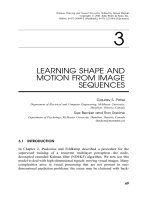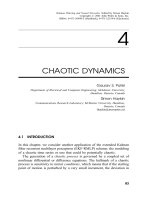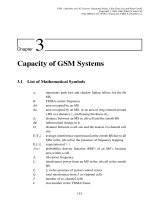Tài liệu Car benefits and car fuel benefits doc
Bạn đang xem bản rút gọn của tài liệu. Xem và tải ngay bản đầy đủ của tài liệu tại đây (211.57 KB, 10 trang )
Helpsheet 203
Tax year 6 April 2011 to 5 April 2012
Car benefits and car fuel benefits
This helpsheet gives you information to help you fill in boxes 9 and 10,
about company cars, on the Employment page of your tax return. It is also
relevant to box 15.
It contains a Working Sheet for you to use and an example of a completed
Working Sheet. You will need a P11D, or equivalent information, from
your employer.
Fill in a separate Working Sheet for each car ‘made available to you’
in the year ended 5 April 2012, unless the car was a temporary replacement
(see ‘Replacement cars’ on page 4), or qualified as a ‘pool car’ for
tax purposes (your employer will be able to give you details of this).
Made available to you also includes the car being made available
to members of your family or household.
On the Employment page of your tax return:
• add the figures in box T (car benefit on the Working Sheet) for all cars and
enter the total in box 9
• add the figures in box Z (car fuel benefit) for all cars and enter the total
in box 10
• include in box 15 the benefit of any chauffeur provided because of your
employment (your employer will give you this information).
Car benefit
Box A The price of the car
This will usually be the manufacturer’s published UK list price of the car
on the day before it was first registered, including VAT, car tax (where
appropriate), delivery charges and number plates. If no such price exists,
use the list price of the importer or (failing that) the distributor.
This rule is changed if the car was manufactured from new to run on road
fuel gas, whether liquid petroleum gas (LPG) or compressed natural gas
(CNG), and was first registered in that form before 1 January 2000. It will
only have an official CO
2
emissions figure for petrol, not for gas.
Reduce the list price by the amount it is reasonable to attribute to the cost
of manufacturing it to run on gas as well – you can normally use the list
price of the equivalent petrol model.
For cars with no list price, use the price which might reasonably have been
expected to be the car’s UK list price including accessories, on the day before
it was first registered.
For classic cars (those over 15 years old with a market value greater than
the list price and at least £15,000), substitute the car’s market value for
the year minus any capital contribution for the amount otherwise carried
forward from box D.
HS203 2012 Page 1 HMRC 12/11
A
Contacts
Please phone:
•
the number printed
on page TR 1 of
your tax return
• the SA Helpline on
0845 9000 444
•
the SA Orderline on
0845 9000 404
for helpsheets
o
r go to
www.hmrc.gov.uk
Box B The price of accessories
This is the published list price, including VAT, car tax (where appropriate),
and fitting and delivery charges, of:
• any accessories with the car when it was first made available to you but
not included in box A (whether or not they were available at any time
in 2011–12), plus
• any accessories added later and available at any time in 2011–12.
Do not include:
• any mobile phone
• any accessory designed solely for use by a disabled person
• if you held a disabled person’s ‘blue badge’ when the car was first made
available to you, any equipment which enables you to use the car in spite
of the disability for which you hold the badge
• any accessory which you own yourself
• the cost of converting the car to run on LPG or CNG after it was
first registered
• any accessory which was necessarily provided for use in the performance
of the duties of your employment
• any accessories which are never fixed to the car, such as maps or rugs.
Also do not include under ‘accessories added later’, those accessories which:
• were added before 1 August 1993 if the car was available to you before
then, or
• had a price of less than £100, or
• replaced previous accessories and were not superior to them, or
• were added after the car was first made available to you but were removed
before 6 April 2011.
Box D Capital contributions
Enter the amount (to a maximum of £5,000) of any lump sum payments
you made towards the cost of buying either the car or accessories for which
the price is included in boxes A or B. Payments you made in earlier years
towards the cost of this car and accessories still count.
Box E This figure is the price of the car for tax purposes
It is not the price paid for the car, but the figure used to calculate the value of
the car as a benefit to you, on which you pay tax. It will be the same figure
each year you have the car, unless accessories are added in later years (see
box B above). From 6 April 2011 this figure is no longer limited to £80,000.
Box F Calculating the appropriate percentage
You will need the approved CO
2
emissions figure for cars registered
in 1998 or later. Most such cars have one: if this car does not for any rea-
son, the appropriate percentage is based on the engine size. Engine size
is also used for all cars registered before 1998. You can find the approved
CO
2
emissions figure:
• for cars first registered on or after 1 March 2001 – from the Vehicle
Registration Certificate (V5C)
• for cars first registered from 1 January 1998 to 28 February 2001
from www.vcacarfueldata.org.uk (download the data after the car was
first registered)
HS203 2012 Page 2
HS203 2012 Page 3
• from the manufacturer (or importer, where appropriate). The manufacturer
holds the type approval certificate for each type of car, and this includes
t
he approved CO
2
e
missions figure for the type to which the vehicle con-
f
orms. The manufacturer should provide this information if asked to, nor-
m
ally by providing a certificate of conformity. Although manufacturers are
entitled to charge a small fee, some are happy to provide this information
free of charge.
Enter the unrounded figure at box F. Then follow the instructions on the
Working Sheet to calculate the appropriate percentage at box H, J, K, or M.
Box N Car benefit for the full tax year
Calculate this here.
Box P Periods when the car is 'unavailable' to you
This reduces the annual benefit charge in box N in proportion to the num-
ber of days the car was unavailable to you. It is treated as unavailable on
any day:
• before it was first made available to you
• after it finally stopped being available to you, and
• if that day fell within a continuous period of 30 days or more throughout
which it was not available to you (for example, because it was under
repair). There is no time apportionment for periods of less than 30 days.
See page 4 for the treatment of ‘replacement cars’ in this situation. Please
note that this is a test of availability of the car, not of whether it was used.
You might not use a car for a continuous period of 30 days, but it may
still be available to you during that period.
Box S Payments for private use
If you were required to make payments as a condition of the car being avail-
able for private use during the year, enter the amount you paid for
the year in box S.
Box T This is the car benefit charge
It is the amount on which you will pay tax for the benefit of having this car.
You should add it to any other box T amounts for other cars made available
to you in the year, and include the total in box 9 of the Employment page
of your tax return, together with any van benefit charge to which you may
be liable.
Car fuel benefit
Box Z Car fuel benefit charge
This charge applies if your employer provided you with any fuel for private
use of the car. It is calculated as shown on the Working Sheet. A separate
charge applies for each car, except replacement cars (see page 4).
If you paid for all the fuel for your private use in this car, put zero (‘0’)
in box Z.
The figure at box Z is the amount on which you will pay tax for the benefit of
having fuel provided for private use in this car. You should add it to any other
box Z figures for other cars for which you were provided with fuel for private
use in the year. Please include the total in box 10 of the Employment page of
your tax return, together with any van fuel benefit charge to which you may
be liable.
A
C
ontacts
Please phone:
• the number printed
on page TR 1 of
your tax return
• the SA Helpline on
0845 9000 444
• the SA Orderline on
0845 9000 404
for helpsheets
or go to
www.hmrc.gov.uk
HS203 2012 Page 4
Replacement cars
If your usual car was not available (for instance, while under repair)
for a continuous period of less than 30 days, and during that time
a replacement car was made available to you, you are not taxed on
the replacement car as long as it:
• was not materially better than your usual car, or
• was not made available to you under an arrangement to provide you with
the benefit of a materially better car.
When this applies:
• treat any payment you were required to make for the private use
of the replacement car as though it related to your usual car,
and include the amount at box S
• the fuel benefit charge for your usual car includes any fuel provided
for the replacement car.
Working Sheets
Working Sheets follow to help you calculate the car and car fuel benefits for
each car made available to you in the year.
After that, there are completed Working Sheets using the details
in the example below.
Example
A new company car was made available to Joe Soap before the start of this tax year.
It was an Acme Roadrunner 1.8, first registered on 1 August 2008 with a list price
of £14,500 plus delivery charges of £500. It was powered by petrol and had an official
CO
2
emissions figure of 177g/km.
Joe asked for satellite navigation to be fitted as a factory fitted option and his employer
agreed, provided Joe paid the additional cost of £1,500. As soon as he received it,
Joe realised that the car was not fitted with alloy wheels; once again, his employer
was content to arrange for this to be done if Joe paid the £500 cost of the new wheels.
Joe paid £100 a month for the private use of the car (four payments). His employer pro-
vided all the fuel for the car for both business and private use until 30 June, after
which Joe was required to pay for all his private fuel, and did so.
On 31 July he handed the car back to his employer, collecting another car the next day.
Tables for use with the 2011–12 Working Sheet
T
able 1
Using Tables 2 and 3 below
Use Column 1 for all cars in fuel type A.
Use Column 2 for all cars in fuel type D.
Table 3 Column 3 is used as indicated in box M of the Working Sheet.
Table 2 (Ready reckoner)
Table 3
Key letter Description of fuel or power
E Electric (and any car which cannot, in any circumstances, emit CO
2
by being driven)
ZERO CHARGE 2010–11 to 2014–15
D All diesel cars (previously types D and L)
A All other types (previously types P, B, C, G and H)
HS203 2012 Page 5
Cylinder capacity (cc) Column 1 (%) Column 2 (%) Column 3 (%)
0 to 1400 15 18 15
1401 to 2000 25 28 22
Over 2000 35 35 32
Rotary engined cars 35 35 32
CO
2
Column 1 Column 2 CO
2
Column 1 Column 2 CO
2
Column 1 Column 2
emissions emissions emissions
(g/km) (%) (%) (g/km) (%) (%) (g/km) (%) (%)
1 to 75 58155 21 24 195 29 32
(unrounded)
76 to 120 10 13 160 22 25 200 30 33
(unrounded)
121 to 125 15 18 165 23 26 205 31 34
130 16 19 170 24 27 210 32 35
135 17 20 175 25 28 215 33 35
140 18 21 180 26 29 220 34 35
145 19 22 185 27 30 225* 35 35
150 20 23 190 28 31
* This is the maximum CO
2
value for which a different percentage applies. Use this value if the figure at box G is greater
than the maximum.
Cars registered on or after 1 January 1998 with
an approved CO
2
emissions figure of more than 120g/km
Approved CO
2
emissions figure in box F, rounded down
to the next lowest 5g/km,
for example, 175
Using Table 2, work out from the figure in box G
the percentage to enter in box H
Go straight to box N
Cars registered on or after 1 January 1998 with
an unrounded approved CO
2
emissions figure
not exceeding 120g/km
For these ‘qualifying low emissions cars’ or QUALECs,
use Table 2 and the figure from box F to work out
the percentage to use
Go straight to box N
Cars registered on or after 1 January 1998 without
an approved CO
2
emissions figure
Work out the percentage to enter in box K. Use Table 3
for fuel types A and D
Go straight to box N
All cars registered before 1 January 1998
Enter the engine size
Appropriate percentage
Use Column 3 of Table 3 to work out the percentage
to enter in box M
Calculate the car benefit for a full year (round down
to the next whole number)
Multiply E by H, J, K or M
If the car was available for the whole of the tax year,
copy the figure in box N into box R. If not, enter
the period for which the car was available
From DD MM YYYY
To
G
K
%
J
%
H
g/km
L
cc
M
%
N
£ 0 0
•
%
HS203 2012 Page 6
Working Sheet for car benefit charge
Make
Model
Enter the list price of the car including standard accessories
(from form P11D)
Enter the price of all accessories (from form P11D)
Add together A + B
Enter capital contributions you made towards the cost
of the car or accessories, maximum £5,000
The price used to calculate the car benefit charge for
the year (C minus D)
Calculating the appropriate percentage
Enter the date that the car was first registered
DD MM YYYY
Approved CO
2
emissions figure, if the car has one:
enter the unrounded figure, for example, 177
Enter the key letter (A or D) for the car’s fuel or power
type from Table 1
Next:
• for cars registered on or after 1 January 1998 with
an approved CO
2
emissions figure
— go to box G if it is greater than 120g/km
— otherwise go to box J
• for cars registered on or after 1 January 1998 without
an approved CO
2
emissions figure, go to box K
• for type E cars there is no charge 2010–11 to 2014–15
• for cars registered before 1 January 1998, go to box L
g/km
F
£ 0 0
•
E
£ 0 0
•
D
£ 0 0
•
C
£ 0 0
•
B
£ 0 0
•
A
HS203 2012 Page 7
Enter the total days that the car was unavailable
Deduction for unavailability (round up to the next whole
pound) N x P/366
Car benefit for the period car was available
(N minus Q)
Enter any required payments for private use of the car
in the year, which were actually made
Car benefit charge for this car (R minus S)
If more than one car was available to you in the year,
add together all the figures at box T on each
Working Sheet and transfer the total to box 9
on your Employment pages, together with any
van benefit charge to which you may be liable
£ 0 0
•
T
£ 0 0
•
S
£ 0 0
•
R
£ 0 0
•
Q
P
Working Sheet for car fuel benefit
charge
If any fuel was provided for your private use for which
you
did not pay in full, calculate the charge for the whole
y
ear.
£18,800 x H, J, K or M
Days the car was unavailable (box P aside)
If the provision of fuel was withdrawn and not reinstated
later in the year, enter the date below and complete box
W. Otherwise go straight to box X
Date the provision of fuel was withdrawn DD MM YYYY
Days after fuel was withdrawn which are not already
counted in box P
Total days for which no car fuel benefit charge applies
P + W
Deduction (round up to the next whole pound)
U x X/366
Car fuel benefit charge for this car (U minus Y)
Enter the figure at box Z in box 10 on your
Employment pages – if more than one car was avail-
able to you in the year, add together all the figures at
box Z on each Working Sheet and transfer the total to
box 10, together with any van fuel benefit charge to
which you may be liable
£ 0 0
•
Z
£ 0 0
•
Y
X
W
V
£ 0 0
•
U
Working Sheet for car benefit charge –
worked example
Make
Model
Enter the list price of the car including standard accessories
(from form P11D)
Enter the price of all accessories (from form P11D)
Add together A + B
Enter capital contributions you made towards the cost
of the car or accessories, maximum £5,000
The price used to calculate the car benefit charge for
the year (C minus D)
Calculating the appropriate percentage
Enter the date that the car was first registered
DD MM YYYY
Approved CO
2
emissions figure, if the car has one:
enter the unrounded figure, for example, 177
Enter the key letter (A or D) for the car’s fuel or power
type from Table 1
Next:
• for cars registered on or after 1 January 1998 with
an approved CO
2
emissions figure
— go to box G if it is greater than 120g/km
— otherwise go to box J
• for cars registered on or after 1 January 1998 without
an approved CO
2
emissions figure, go to box K
• for type E cars there is no charge 2010–11 to 2014–15
• for cars registered before 1 January 1998, go to box L
g/km
F
£ 0 0
•
E
£ 0 0
•
D
£ 0 0
•
C
£ 0 0
•
B
£ 0 0
•
A
Cars registered on or after 1 January 1998 with
an approved CO
2
emissions figure of more than 120g/km
Approved CO
2
emissions figure in box F, rounded down
to the next lowest 5g/km,
for example, 175
Using Table 2, work out from the figure in box G
the percentage to enter in box H
Go straight to box N
Cars registered on or after 1 January 1998 with
an unrounded approved CO
2
emissions figure
not exceeding 120g/km
For these ‘qualifying low emissions cars’ or QUALECs,
use Table 2 and the figure from box F to work out
the percentage to use
Go straight to box N
Cars registered on or after 1 January 1998 without
an approved CO
2
emissions figure
Work out the percentage to enter in box K. Use Table 3
for fuel types A and D
Go straight to box N
All cars registered before 1 January 1998
Enter the engine size
Appropriate percentage
Use Column 3 of Table 3 to work out the percentage
to enter in box M
Calculate the car benefit for a full year (round down
to the next whole number)
Multiply E by H, J, K or M
If the car was available for the whole of the tax year,
copy the figure in box N into box R. If not, enter
the period for which the car was available
From DD MM YYYY
To
K
%
J
%
H
g/km
G
L
cc
M
%
N
£ 0 0
•
%
HS203 2012 Page 8
1 5 0 0 0
2 0 0 0
1 7 0 0 0
2 0 00
1 5 0 00
1 7 7
1 75
2 5
acme
RoadRunneR 1.8
0 1 0 8 2 0 08
3 7 5 0
0 6 0 4 2 0 1 1
3 1 0 7 2 0 1 1
HS203 2012 Page 9
Enter the total days that the car was unavailable
Deduction for unavailability (round up to the next whole
pound) N x P/366
Car benefit for the period car was available
(N minus Q)
Enter any required payments for private use of the car
in the year, which were actually made
Car benefit charge for this car (R minus S)
If more than one car was available to you in the year,
add together all the figures at box T on each
Working Sheet and transfer the total to box 9
on your Employment pages, together with any
van benefit charge to which you may be liable
£ 0 0
•
T
£ 0 0
•
S
£ 0 0
•
R
£ 0 0
•
Q
P
Working Sheet for car fuel benefit
charge
If any fuel was provided for your private use for which
you
did not pay in full, calculate the charge for the whole
y
ear.
£18,800 x H, J, K or M
Days the car was unavailable (box P aside)
If the provision of fuel was withdrawn and not reinstated
later in the year, enter the date below and complete box
W. Otherwise go straight to box X
Date the provision of fuel was withdrawn DD MM YYYY
Days after fuel was withdrawn which are not already
counted in box P
Total days for which no car fuel benefit charge applies
P + W
Deduction (round up to the next whole pound)
U x X/366
Car fuel benefit charge for this car (U minus Y)
Enter the figure at box Z in box 10 on your
Employment pages – if more than one car was avail-
able to you in the year, add together all the figures at
box Z on each Working Sheet and transfer the total to
box 10, together with any van fuel benefit charge to
which you may be liable
£ 0 0
•
Z
£ 0 0
•
Y
X
W
V
£ 0 0
•
U
2 4 8
2 5 4 0
1 2 1 0
4 0 0
810
3 5 8 2
4 7 0 0
1 1 1 8
3 1
2 7 9
3 0 0 6 2 0 1 1
These notes are for guidance only and reflect the position at the time of writing. They do
not affect any rights of appeal. Any subsequent amendments to these notes can be found
at www.hmrc.gov.uk
12/11









